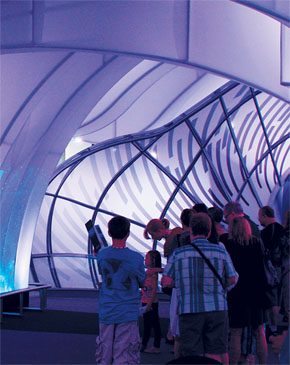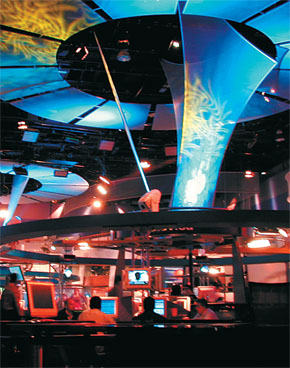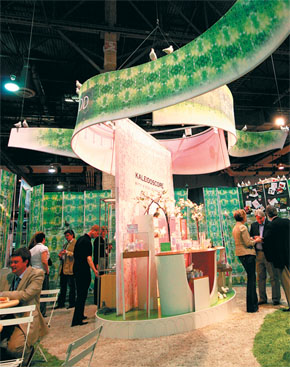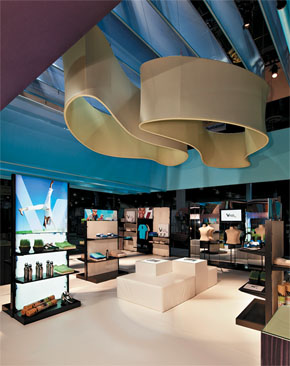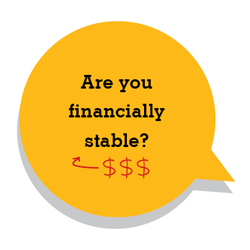fabric |
 |
 echnically speaking, fabric exhibits have been around since at least the 1880s, when folks like Clark Stanley and Dr. S. Andral Kilmer - inventors of Snake Oil
Liniment and Swamp Root Herbal Tonic, respectively - hawked their wares using little more than canvas tents. Luckily, these questionable elixirs were eventually replaced by pharmaceuticals with a lower quack factor. But for the next hundred years, fabric exhibits remained
almost as archaic as the iron corset. echnically speaking, fabric exhibits have been around since at least the 1880s, when folks like Clark Stanley and Dr. S. Andral Kilmer - inventors of Snake Oil
Liniment and Swamp Root Herbal Tonic, respectively - hawked their wares using little more than canvas tents. Luckily, these questionable elixirs were eventually replaced by pharmaceuticals with a lower quack factor. But for the next hundred years, fabric exhibits remained
almost as archaic as the iron corset.
Enter game changers Transformit Inc. and Moss Inc., two of the trade show industry's first fabric-exhibit firms (the latter of which was originally a tent manufacturer as far back as 1975). When they opened their doors in the 1980s (in Gorham, ME, and Elk Grove Village, IL, respectively), they started a fabric-exhibit evolution that,
according to many industry experts, changed the exhibit-floor landscape much the way Spandex reshaped fitness fashion. With its unique aesthetic qualities, flexibility, and lightweight properties - which help satiate the industry's ever-present desire to decrease weight-based drayage and shipping fees while also creating dramatic exhibit designs - this '80s-born sensation became a major player among exhibit-material choices.
Thankfully, that fabric-exhibit
evolution didn't fade away with
Donkey Kong and Teddy Ruxpin. Over the last 30 years, several key fabric-exhibit firms have hit the scene, and fabric exhibits have continued to evolve. Gone are days when fabric components were limited to square, straight shapes, and when full-color graphics featured warped and twisted images, faded colors, and more seams than a Chris March gown. Today's fabric systems offer architecture frameworks and material choices that allow exhibitors to create curvaceous, wrinkle-free shapes for use in endless applications.
Plus, given recent innovations in digital-printing technology and equipment, suppliers can offer high-quality, mural-like wide-format fabric graphics, and they can print with fade-resistant inks in a full spectrum of
colors. In fact, given the evolutionary improvements of the last 30 years, fabric is as integral to effective exhibit design as Gor-Tex is to smart campers.
For exhibit managers, however, all is not buttons and bows just yet. When it comes to fabric exhibits and components, most exhibitors know less about them than Stanley and Kilmer knew about magic elixirs. While traditional materials like laminate and Gatorfoam are pretty cut and dried, fabric has its own unique qualities and handling requirements. And if you don't bone up on fabric prior to a purchase, it can cause serious wrinkles in your program.
Thus, EXHIBITOR enlisted nine fabric-exhibit experts to help create the following pre-purchasing primer. Offering everything from the benefits and drawbacks of fabric exhibit
components to key topics to discuss with your vendors, the following pages will bring you up to speed on today's fabric exhibitry, help you make more informed fabric-purchasing decisions, and ensure that you and your program never get fleeced.
Why Fabric is Fashionable
Fabric exhibitry strutted onto the worldwide exhibition stage with good reason; it offers countless benefits and
minimal drawbacks for exhibitors. Among them, however, the most important plus seems to be fabric's lighter weight and smaller volume than that of traditional exhibit materials,
including everything from wood and laminate to Sintra.
The minimal weight of fabric means lower shipping and drayage fees compared to traditional materials. Given the fact that drayage rates per CWT (per 100 pounds) run an average
of $83.51 (according to the 2011 Trade Show Labor Rate Benchmarking Survey), even a minimal drop on the scale can save hundreds of dollars in drayage costs at just one show. In addition, unlike hard-surface exhibit materials, fabric folds up neater than a French seam, says Jana McQuilkin, marketing manager at Moss. So
fabric exhibit components also take up minimal space in shipping containers and exhibit-house storage space, which in turn means they also minimize storage and shipping costs.
Another logistical benefit of fabric is that setup is relatively simple. Many architectural systems used in exhibits will accept fabric via easy-to-attach fasteners such as hook-and-loop tape and fabric-attached gaskets. Thus, installation and dismantle is usually a snap compared to hard-surface booth components, McQuilkin says. And since fabric is often easier to maneuver than solid panels, I&D costs for fabric components are normally lower than those of similar, hard-surface structural elements.
Fabric is also easy to care for, says Jim Knoche, exhibit-sales rep at St. Louis-based Lawrence Fabric Structures Inc. "Exhibit fabric is fairly wrinkle resistant and easy to clean with the proper tools and detergents,"
he says. "Plus, some fabrics can even be washed several times without damaging graphic images or color." That ease of maintenance means exhibitors can spend less time and money on setup and cleaning.
Another factor that makes fabric attractive to exhibitors is that it's incredibly versatile. "Fabric exhibit components can be incorporated into almost any booth design, performing practically any function," says Transformit's vice president of marketing, Matt Rawdon. Traditional fabric elements include banner stands, tabletop exhibits, booth walls and dividers, overhead identification signage, and graphics.
"Today's tensioned-fabric offerings can also conform around organic, three-dimensional forms and create dramatic, curved architecture for a variety of new uses," says Valerie Cuchna, material resource liaison at Fabric Images Inc., another fabric-exhibit pioneer, based in Elgin, IL. The names of these new tensioned-fabric shapes vary by supplier but include options such as wings, rings, teardrops, crescents, flutes, and more, each one of which can be an eye-catching exhibit element all its own.
Given the prevalence of exhibit
architecture that accepts fabrics, various fabrics can also be used in place of just about any hard-surface panel to create reception desks, kiosks, and more, says Jon Weingarten, president and CEO of Dazian LLC, a fabric-environment provider in South Hackensack, NJ. Some fabrics also have sound-absorbing properties, which can be used to create a quiet haven such as a conference room or theater in your space. What's more, fabric can act as a projection surface for everything from in-booth presentations to eye-catching gobos, Weingarten says.
Fabric also cuts costs when you need to replace your graphics, as fabric components and fabric graphics are less expensive than their hard-surface counterparts. "So when it's time to change your messaging or your color scheme, swapping fabric panels or graphics is a lot cheaper than changing out hard-surface
materials such as Gatorboard or
laminate," Knoche says.
Aside from all of these functional benefits, fabric exhibitry can provide a unique aesthetic to your space, and can act as a sort of traffic-building tool. "The texture, dimensionality, form, color, and reflective qualities of fabric can dramatically shift the feel of the booth," says Leo Boczar, director of communication at Fabric Images. "Plus, people are drawn to the sensory experience of touching fabric. When you're shopping for clothes or furniture, you can't help but finger the materials. Today's eye-catching and highly textural fabric options afford attendees the luxury of a moment of interaction with the exhibit itself. In this brief moment, you've created a literal touchpoint and successfully captured their attention. Now you
just have to reel attendees in and open a conversation."
Finally, given fabric's minimal weight and volume, it requires less fuel to move it from place to place, and that makes fabric a Green material option, says Tom Bowman, president of Bowman Design Group of Signal Hill, CA. Many fabrics are recyclable, and some fabric graphics
are easy to repurpose as table throws, corporate-office signage, corporate event messaging, etc. "Eco-friendly fabrics are a good alternative to typical exhibit graphics such as Lexan, Fome-Core, Gatorfoam,
and Sintra," Bowman says. "One option called Paradise Fabric by Eco-Systems Sustainable Exhibits Inc. is made from 100-percent recycled soda bottles. It is versatile and durable, prints beautifully, and has a gentle environmental footprint."
Before You Bite the Bolt
As you can see, fabric offers its fair share of advantages regarding everything from aesthetics to logistics. So for many exhibitors, the material world is certainly appealing. But before you make a significant fabric-components purchase, consider the not-so-good news about fabric, which involves durability, color consistency and quality, and what some suppliers
call "repairability."
Topping the list of drawbacks is the fact that almost all fabric rips, runs, stains, fades, and molds. "So while careful handling will usually ensure you get several years of use from your fabric, the material requires
a different type of care than its hard-surface counterparts," Rawdon says. While many exhibit fabrics now have antimicrobial properties - and you can add a nanotechnology coating that increases resistance to stains, dirt, and mold - most nontreated fabrics have a high risk of molding in warm, humid environments. In addition, Cuchna warns that once you severely tear or stain your fabric component, it's difficult or impossible to repair, and you probably won't be able to return it to its original, blemish-free state.
|

1. Wash your hands prior to handling your exhibit fabric, or better yet, wear a pair of white gloves when doing so.
Even hands that appear clean can transmit natural oils present on the skin, and once this gets on your fabric, it can attract dirt.
2. Determine if your fabric can be ironed or steamed and/or whether it will likely need such a treatment prior to each show.
Packing-related wrinkles may simply "fall out," i.e., disappear, within a few hours after the fabric is hung, and steaming is a viable option for most exhibit fabrics. But if you need to iron the fabric, use a permanent-press setting and place a sheet of paper that's free of ink and wax between the iron and fabric. Keep the iron in constant motion and away from silicone edging materials.
3. Inspect and clean your exhibit fabrics before you dismantle
your exhibit and fold the fabric.
Not only will you ensure that your fabric is ready for the next show, but stains can often bleed through many layers of fabric.
4. Talk to your fabric supplier about proper washing and drying methods, as some fabrics will practically disintegrate in a washing machine.
However, most synthetics can safely be machine washed with mild detergents, no bleach, and a cold water setting. Lightweight mesh fabrics should be laundered in net bags to prevent abrasion to the fabric. Also, unless specified by your supplier, avoid machine drying your fabric, which can scorch or melt many materials.
5. Ensure your fabric is completely dry before it's stored.
Just as wet towels grow mold, so, too, will damp fabrics.
6. Fold fabrics so the graphics
face inward.
That way, the back side of the fabric will face out, preventing the "good" side from being stained or damaged during transport.
7. Store fabric in a dry room where the temperature remains between 40 and 80 degrees.
Some fabrics become brittle or meld together when exposed to extreme low or high temperatures, and 40 to 80 degrees is optimal.
|
Similar care needs to be taken to prevent fading. "Just like your car fades in the sun, so, too, will your exhibit fabric if exposed to ultraviolet light," says Elissa Decker, Moss' fabric product manager for research and
development. You can take certain precautions, such as limiting your fabric's exposure to UV rays and
purchasing UV-protected fabrics.
But particularly in outdoor-exhibiting situations, fabric colors and graphics
will fade over time. "Dye-sublimation printing decreases the risk of fading
for most materials," Rawdon says. "However, minor fading can create color-matching issues when you have to replace one fabric panel out of a series of multiple, similarly colored panels. That new, hot-pink panel, for example, can make the existing five-year-old pink panels look dull and faded by comparison."
Along these same lines, matching new to existing fabrics can be difficult considering variances in dye lots. "Fabric is dyed in lots, and colors may vary slightly from one lot to another," Decker says. "This variation will probably only be noticeable if fabrics from two different lots are installed side by side. If, when you order your exhibit, you know that within a year you will be adding pieces in close proximity to other pieces in your exhibit and you are using a custom color, it may be worth asking your fabric supplier if you can buy a larger amount of the fabric and have it hold that color for you to avoid dye-lot issues."
Careful handling and color-related issues are important considerations if you want to keep your fabrics looking
their best. But proper vendor selection,
particularly when it comes to graphics, is paramount as well. With advanced inks, materials, and equipment, most fabric suppliers have mastered the art of printing on stretch fabric, creating
full-color graphics, and avoiding
errors caused by incorrect patterning. But sometimes you run into a supplier that is more of an apprentice than a master. "Some exhibitors and vendors
choose the wrong stretch fabrics or the wrong graphics-application method for a specific fabric, and when they stretch the material over a frame, the graphic image or text distorts," Knoche says.
Rawdon reiterates the importance of proper vendor selection, but also cautions that exhibitors need to listen to their vendors' recommendations. "Selecting the right fabric for your needs looks easier than it is," Rawdon says. "Unless you are a fabric expert, your fabric selection should be guided by a professional with plenty of experience and a passion for quality. After all, there's a reason why a suit by Jos. A. Bank doesn't look as good as one by Georgio
Armani. It's about craftsmanship, quality, material selection, etc. Choose your supplier wisely, and ask a lot of questions, but in the end, let the experts recommend the right fabric for your needs."
The Material Marketplace
While understanding the pros and cons of fabric is your first step on
the yellow-suede road to purchasing
Oz, a fabric-savvy exhibitor also needs to know what questions to ask of, and what topics to broach with, potential fabric suppliers. Surely, most suppliers aren't out to take advantage of their clients. But some may make innocent assumptions that can negatively impact your purchasing decisions. So it doesn't matter if your fabric supplier is more polished than a Burberry wool trench. You're shooting yourself in the foot pedal if you don't touch on several key topics before you purchase your next fabric exhibit component.
A key, multipoint question to ask your supplier is: How much stretch content does this fabric have, is it suitable for my exhibit components, and how will the fabric "rebound" over time? A fabric's stretch content must be appropriate for its intended use, both in terms of the architectural system that will be used to support it and the amount of time you intend to use it. For example, a fabric with limited stretch capabilities probably isn't a good option for a taut, tensioned-fabric system. And a material with extreme levels of stretch may not rebound after years of use.
Also, particularly if you plan to tension the fabric or use it for exhibit graphics, ask your supplier whether the fabric is a two-way or a four-way stretch. "When you know you're going
to stretch the material, fabric with two-way stretch can be problematic," says Boi Smit, president of Cees Smit Inc. in Los Angeles. "This fabric only stretches top to bottom or side to side, and when pulled, it can create inconsistencies and possibly distort graphic images." It's not that two-way stretch doesn't have its uses. But you need to ensure that the fabric's ability to stretch - and the directions in which it's capable of stretching - matches your exhibiting needs.
In addition to the fabric's stretch factor, also inquire about its thickness (aka weight). The amount of transparency the fabric has is generally determined by its weight, Smit says. The heavier the fabric, the less transparent it will be. And in some instances, fabric transparency or a lack thereof is essential to meeting your design objectives. For example, you don't want your conference-room walls to comprise sheer scrim
if meeting privacy is paramount.
Similarly, also query your supplier
about available fabric widths. The wider the fabric, the fewer seams you're going to have in the finished product. That said, however, ensure that production equipment at your fabric supplier and/or graphics-production company can handle whatever width fabric you choose for your exhibit, as older equipment may not be large enough to work with today's wide-width options.
Supplier capabilities are also a
concern when it comes to the fabric's movement and your use of color. Fabric ripples, waves, and sometimes, it even flutters. Certainly, adding movement to an exhibit can be a fantastic traffic draw, and you might even prefer to have fabric graphics scrolling via a banner-stand system, or maybe you want that overhead canopy to lift in the breeze now and then. But always inquire about the amount of movement each fabric and fabric-framework system will offer to ensure that your fabric components' "flappability" matches your needs.
Because faded, mismatched, and washed-out colors and graphics can ruin an otherwise perfect fabric, Rawdon suggests that you pepper
your suppliers with the following
questions regarding color and graphics: How well does this fabric take printing, and what form of print process is best? Is the material UV protected? Will the colors fade or run if washed? What cleaning products should I use with this material to ensure color safety? A ton of prepurchase questions regarding color quality are far better than an ounce of post-purchase remorse.
An equal amount of questions should be launched regarding fabric durability. Surely, ultra-durable fabrics like denim, leather, and burlap aren't the best solution for every exhibit. But you need to discuss the durability of all fabrics, and query your providers about proper handling and storage. For example, will the fabric melt if it's exposed to temperatures above 80 degrees, or become brittle under 40 degrees? Does it have antimicrobial properties, or will molding be an issue? Should it be folded in a certain manner for shipping and transport? What information must I pass on to my I&D team to ensure safe and proper setup and teardown? Will the fabric wrinkle easily, and if so, is ironing an option?
In terms of fire regulations, Decker says, two questions are critical: 1) "Is the fabric up to code for every show (and each trade show's corresponding country, state, city, and venue regulations) in which I intend to use it?" and 2) "Can I get a copy of the fabrics' Flame Retardancy Certificate as soon as possible in the design process?" Bring this certificate with you to all shows at which you exhibit in case fire-prevention professionals ask to see it.
Finally, if all of your fabric-related questions have been answered to your satisfaction and you're on the verge of making a purchase, Cuchna suggests that you incorporate several "So how long is that going to take?" questions into prepurchase conversations. "Some fabrics will take longer than others to secure, and some graphic-printing processes will require more time and attention than others," she says. "It's not so much that fabric production takes longer than traditional exhibit-component manufacturing. But never make
assumptions about the production
timelines; ask your fabric supplier
for estimates."
Given the lightweight, flexible, and aesthetically pleasing attributes of fabric components, they appear tailor-made for the demands of the trade show world. But before you finalize any fabric-component purchase, make sure you've analyzed the preceding pros and cons and that you've done your homework by asking suppliers a smattering of questions. A little nuts-and-bolts knowledge will help you iron out any wrinkles long before they set in. E
|
|
|
|




 echnically speaking, fabric exhibits have been around since at least the 1880s, when folks like Clark Stanley and Dr. S. Andral Kilmer - inventors of Snake Oil
Liniment and Swamp Root Herbal Tonic, respectively - hawked their wares using little more than canvas tents. Luckily, these questionable elixirs were eventually replaced by pharmaceuticals with a lower quack factor. But for the next hundred years, fabric exhibits remained
almost as archaic as the iron corset.
echnically speaking, fabric exhibits have been around since at least the 1880s, when folks like Clark Stanley and Dr. S. Andral Kilmer - inventors of Snake Oil
Liniment and Swamp Root Herbal Tonic, respectively - hawked their wares using little more than canvas tents. Luckily, these questionable elixirs were eventually replaced by pharmaceuticals with a lower quack factor. But for the next hundred years, fabric exhibits remained
almost as archaic as the iron corset. 